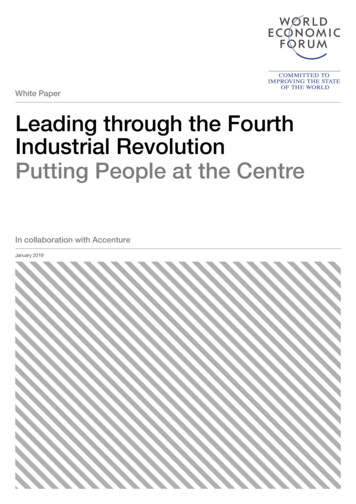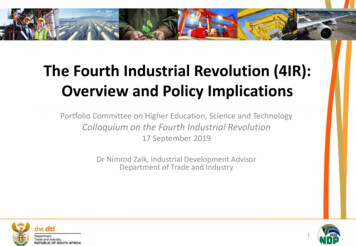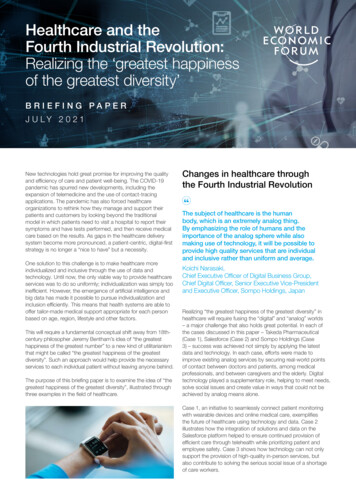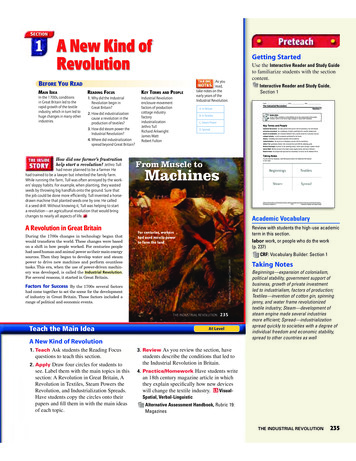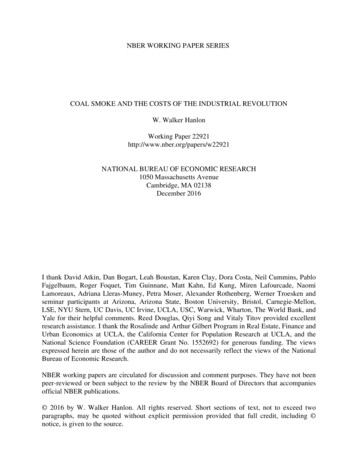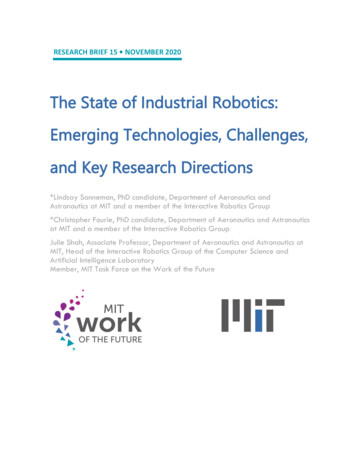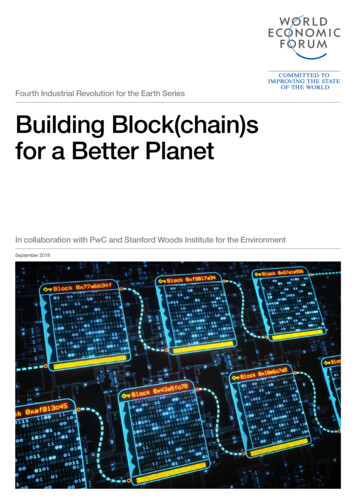
Transcription
Fourth Industrial Revolution for the Earth SeriesBuilding Block(chain)sfor a Better PlanetIn collaboration with PwC and Stanford Woods Institute for the EnvironmentSeptember 2018
Building Block(chain)s for a Better Planet is published bythe World Economic Forum System Initiative on Shapingthe Future of Environment and Natural Resource Security inpartnership with PwC and the Stanford Woods Institute forthe Environment. It was made possible with funding from theMAVA Foundation. It forms part of a series of reports fromthe Fourth Industrial Revolution for the Earth project, run inassociation with the World Economic Forum Centre for theFourth Industrial Revolution.About “The Fourth Industrial Revolution for the Earth”seriesThe “Fourth Industrial Revolution for the Earth” is apublication series highlighting opportunities to solvethe world’s most pressing environmental challenges byharnessing technological innovations supported by newand effective approaches to governance, financing andmultistakeholder collaboration.About the World Economic ForumThe World Economic Forum, committed to improvingthe state of the world, is the International Organizationfor Public-Private Cooperation. The Forum engages theforemost business, political and other leaders of society toshape global, regional and industry agendas.World Economic Forum91-93 route de la CapiteCH-1223 Cologny/GenevaSwitzerlandWorld Economic Forum 2018 – All rights reserved.No part of this publication may be reproduced ortransmitted in any form or by any means, includingphotocopying and recording, or by any information storageand retrieval system.
Contents3Preface4Foreword5Executive summary7Our planet: The challenge andopportunity9The building blocks: Overview ofblockchain and its maturity12The blockchain opportunity forour environment14Blockchain game changers forthe Earth22Blockchain blockers and theunintended consequences26Conclusions andrecommendations31Acknowledgements32Annex I33Annex II34EndnotesPrefaceThe Fourth Industrial Revolutionand the EarthThe majority of the world’s current environmental problems can be traced backto industrialization, particularly since the “great acceleration” in global economicactivity since the 1950s. While this delivered impressive gains in human progressand prosperity, it has also led to unintended consequences. Issues such as climatechange, unsafe levels of air pollution, depletion of forestry, fishing and freshwaterstocks, toxins in rivers and soils, overflowing levels of waste on land and inoceans, and loss of biodiversity and habitats are all examples of the unintendedconsequences of industrialization on our global environmental commons.As the Fourth Industrial Revolution gathers pace, innovations are becomingfaster, more efficient and more widely accessible than ever before. Technologyis becoming increasingly connected, and we are now seeing a convergence ofthe digital, physical and biological realms. Emerging technologies, including theInternet of Things (IoT), virtual reality and artificial intelligence (AI), are enablingsocietal shifts as they seismically affect economies, values, identities andpossibilities for future generations.There is a unique opportunity to harness the Fourth Industrial Revolution – and thesocietal changes it triggers – to help address environmental issues and transformhow we manage our shared global environment. Left unchecked, however, theFourth Industrial Revolution could have further unintended negative consequencesfor our global commons. For example, it could exacerbate existing threats toenvironmental security by further depleting global fishing stocks, biodiversity andresources. Furthermore, it could create entirely new risks that will need to beconsidered and managed, particularly in relation to the collection and ownership ofenvironmental data, the extraction of resources and disposal of new materials, andthe impact of new advanced and automated machines.Harnessing these opportunities and proactively managing these risks will requirea transformation of the current “enabling environment” for global environmentalmanagement. This includes the governance frameworks and policy protocols,investment and financing models, the prevailing incentives for technologydevelopment, and the nature of societal engagement. This transformation will nothappen automatically. It will require proactive collaboration among policy-makers,scientists, civil society, technology champions and investors.If we get it right, it could create a sustainability revolution.Working with experts from the environmental and technology agenda, the “FourthIndustrial Revolution for the Earth” project is producing a series of insight papersdesigned to illustrate the potential of Fourth Industrial Revolution innovations andtheir application to the world’s most pressing environmental challenges. Collectivelyand individually, these papers offer insights into the emerging opportunities andrisks of this fast-moving agenda, highlighting the roles various actors could playto ensure these technologies are harnessed and scaled effectively. The papersare not intended to be conclusive, but rather to act as a stimulant – providingoverviews that provoke further conversation among diverse stakeholders abouthow new technologies driven by the Fourth Industrial Revolution could play asignificant role in global efforts to build environmentally sustainable economies,helping to provide foundations for further collaborative work as this dynamic newagenda evolves. This particular paper looks at blockchain and the planet. Previouspapers in the “Fourth Industrial Revolution for the Earth” series have looked athow the Fourth Industrial Revolution could transform ocean management, enablesustainable cities, and build an inclusive bio-economy that preserves biodiversity,as well as examining how artificial intelligence could be harnessed to addresseconomic, social and governance challenges related to Earth systems.Building Block(chain)s for a Better Planet3
ForewordBlockchain1 is a foundational emerging technology of the Fourth Industrial Revolution, much like theinternet was for the previous (or third) industrial revolution. Its defining features are its distributed andimmutable ledger and advanced cryptography, which enable the transfer of a range of assets amongparties securely and inexpensively without third-party intermediaries. It is also democratized by design– unlike the platform companies of today’s internet – allowing participants in the network to own apiece of the network by hosting a node (a device on the blockchain). Blockchain is more than just atool to enable digital currencies. At its most fundamental level, it is a new, decentralized and globalcomputational infrastructure that could transform many existing processes in business, governanceand society.Dr Celine HerweijerPartner, PwC UKInnovation andSustainability LeaderDominic WaughrayHead of the Centrefor Global PublicGoods,World EconomicForumBlockchain has received considerable hype, ranging from “cryptomania” in the trading markets in2017 to widespread discussions about the breadth and depth of its potential impact across publicand private sectors and society in general. It has also invited scepticism related to its scalability andthe high-energy use of early blockchain platforms.2 As of early July 2018, the total cryptocurrencymarket cap (spanning 1,629 currencies) stands at about 254.67 billion.3 As the architecture forthis transformational technology matures and as both the blockchain hype and scepticism begin torationalize, there is a significant opportunity to shape how blockchain is developed and deployed.A number of blockchain applications and platforms are becoming widely known, starting withBitcoin, which pioneered cryptocurrency (and crypto-assets), followed by Ethereum, which as aplatform for building decentralized applications through smart contracts has inspired a whole new“token economy”. The emergence of applications in voting, digital identity, financing and healthillustrate how blockchain can potentially be used to address global challenges.4 There is now alsoemerging enthusiasm about blockchain’s potential to support global efforts to advance environmentalsustainability. To date, however, there has been little appraisal of the use-cases or systematicorientation to vital environmental opportunities and challenges, much less of how to build the publicprivate collaborations and platforms that will be needed to realize these nascent opportunities.This report focuses on the application of blockchain to address pressing environmental challengessuch as climate change, biodiversity loss and water scarcity. It looks at emerging applications,including those that might be the biggest game changers in managing our global environmentalcommons, while assessing the potential challenges and developing recommendations to addressthem. Some of these applications could dramatically improve current systems and approaches, whileothers could completely transform the way humans interact with – and manage – our environmentalstability and natural resources.Throughout this assessment, it is emphasized that the potential for blockchain lies in its architecturalability to shift, and potentially upend, traditional economic systems – potentially transferring value fromshareholders to stakeholders as distributed solutions increasingly take hold.Sheila WarrenProject Head,Blockchain andDistributed LedgerTechnology,World EconomicForum’s Centre forthe Fourth IndustrialRevolution4If harnessed in the right way, blockchain has significant potential to enable a move to cleaner andmore resource-preserving decentralized solutions, unlock natural capital and empower communities.This is particularly important for the environment, where global commons and non-financial valuechallenges are currently so prevalent.However, if history has taught us anything, it is that such transformative changes will not happenautomatically. They will require deliberate collaboration between diverse stakeholders ranging fromtechnology industries through to environmental policy-makers, underpinned by new platforms that cansupport these stakeholders to advance not just a technology application, but the systems shift thatwill enable it to truly take hold. It is our hope that the following overview of the opportunities, risks andsuggested next steps will stimulate stakeholders to embark on an exciting new action agenda thatbuilds blockchains for a better planet.Building Block(chain)s for a Better Planet
Executive summaryBackgroundPrincipal findingsBlockchain has the potential to transform how humanstransact. It is a decentralized electronic ledger system thatcreates a cryptographically secure and immutable recordof any transaction of value, whether it be money, goods,property, work or votes. This architecture can be harnessedto facilitate peer-to-peer payments, manage records, trackphysical objects and transfer value via smart contracts.Our research and analysis identified more than 65 existingand emerging blockchain use-cases for the environmentthrough desk-based research and interviews with a range ofstakeholders at the forefront of applying blockchain acrossindustry, big tech, entrepreneurs, research and government.This potential to fundamentally redefine how business,governance and society operate has generatedconsiderable hype about blockchain. Despite this hype, itremains a nascent technology with considerable challengesthat need to be overcome, from user trust and adoptionthrough to technology barriers (including interoperability andscalability), security risks, legal and regulatory challenges,and blockchain’s current energy consumption.However, as the technology matures and its applicationacross sectors and systems grows, there is both achallenge and an opportunity to realize blockchain’spotential – not just for finance or industry, but for peopleand the planet. This opportunity comes at a critical juncturein humanity’s development. As a result of the “greatacceleration” in human economic activity since the mid20th century, which has yielded impressive improvements inhuman welfare, research from many Earth-system scientistssuggests that life on land could now be entering a period ofunprecedented environmental systems change.Fortunately, an opportunity is also emerging to harnessblockchain (and other innovations of the Fourth IndustrialRevolution) to address six of today’s most pressingenvironmental challenges that demand transformativeaction: climate change, natural disasters, biodiversityloss, ocean-health deterioration, air pollution and waterscarcity. Many of these opportunities extend far beyond“tech for good” considerations and are connected to globaleconomic, industrial and human systems. Blockchainprovides a strong potential to unlock and monetize valuethat is currently embedded (but unrealized) in environmentalsystems, and there is a clear gap within the market. Inthe first quarter of 2018, for example, 412 blockchainprojects raised more than 3.3 billion through initial coinofferings (ICOs).5 Less than 1% of these were in the energyand utilities sector, representing around 100 million ofinvestment, or around just 3% of the total investment for thequarter.Blockchain use-case solutions that are particularly relevantacross environmental applications tend to cluster aroundthe following cross-cutting themes: enabling the transitionto cleaner and more efficient decentralized systems; peerto-peer trading of resources or permits; supply-chaintransparency and management; new financing models forenvironmental outcomes; and the realization of non-financialvalue and natural capital.The report also identifies enormous potential to createblockchain-enabled “game changers” that have the ability todeliver transformative solutions to environmental challenges.These game changers have the potential to disrupt, orsubstantially optimize, the systems that are critical toaddressing many environmental challenges. A high-levelsummary of those game changers is outlined below:“See-through” supply chains: blockchain can createundeniable (and potentially unavoidable) transparency insupply chains. Recording transactional data throughout thesupply chain on a blockchain and establishing an immutablerecord of provenance (i.e. origin) offers the potential for fulltraceability of products from source to store. Providing suchtransparency creates an opportunity to optimize supplyand-demand management, build resilience and ultimatelyenable more sustainable production, logistics and consumerchoice.Decentralized and sustainable resource management:blockchain can underpin a transition to decentralized utilitysystems at scale. Platforms could collate distributed data onresources (e.g. household-level water and energy data fromsmart sensors) to end the current asymmetry of informationthat exists between stakeholders, enabling more informed –and even decentralized – decision-making regarding systemdesign and management of resources. This could includepeer-to-peer transactions, dynamic pricing and optimaldemand-supply balancing.Raising the trillions – new sources of sustainablefinance: blockchain-enabled finance platforms couldpotentially revolutionize access to capital and unlockpotential for new investors in projects that addressenvironmental challenges – from retail-level investment inBuilding Block(chain)s for a Better Planet5
green infrastructure projects through to enabling blendedfinance or charitable donations for developing countries.On a broader level, there is the potential for blockchain tofacilitate a system shift from shareholder to stakeholdervalue, and to expand traditional financial capital accountingto also capture social and environmental capital. Collectively,these changes could help raise the trillions of dollarsneeded to finance a shift to low-carbon and environmentallysustainable economies. .Incentivizing circular economies: blockchain couldfundamentally change the way in which materials andnatural resources are valued and traded, incentivizingindividuals, companies and governments to unlock financialvalue from things that are currently wasted, discardedor treated as economically invaluable. This could drivewidespread behaviour change and help to realize a trulycircular economy.Transforming carbon (and other environmental)markets: blockchain platforms could be harnessed to usecryptographic tokens with a tradable value to optimizeexisting market platforms for carbon (or other substances)and create new opportunities for carbon credit transactions.Next-gen sustainability monitoring, reporting andverification: blockchain has the potential to transform bothsustainability reporting and assurance, helping companiesmanage, demonstrate and improve their performance, whileenabling consumers and investors to make better-informeddecisions. This could drive a new wave of accountabilityand action, as this information filters up to board-levelmanagers and provides them with a more complete picturefor managing risk and reward profiles.Automatic disaster preparedness and humanitarianrelief: blockchain could underpin a new shared system formultiple parties involved in disaster preparedness and reliefto improve the efficiency, effectiveness, coordination andtrust of resources. An interoperable decentralized systemcould enable the sharing of information (e.g. individual reliefactivities transparent to all other parties within the distributednetwork) and rapid automated transactions via smartcontracts. This could improve efficiencies in the immediateaftermath of disasters, which is the most critical time forlimiting loss of life and other human impacts.Earth-management platforms: new blockchain-enabledgeospatial platforms, which enable a range of value-basedtransactions, are in the early stages of exploration andcould monitor, manage and enable market mechanisms thatprotect the global environmental commons – from life onland to ocean health. Such applications are further away interms of technical and logistical feasibility, but they remainexciting to contemplate.These game changers, and the more than 65 use-casesidentified, offer the exciting potential to build a sustainablefuture; however, as with many emerging technologies,there are a number of risks to manage and challengesto overcome. In broad terms, the challenges relate toblockchain’s maturity as a technology, regulatory and legalchallenges, stakeholders’ trust in the technology, andtheir willingness to invest and participate in applications.Managing and overcoming these risks and challenges willrequire stakeholders to work together to develop solutions6Building Block(chain)s for a Better Planetthat are effective, holistic, relevant and deployable. Currently,such collaborative efforts are few in number, making italmost impossible for stakeholders to fully harness thepotential opportunities that blockchain technology provides.Harnessing blockchain technologies to drive sustainable andresilient growth and a new wave of value creation will requiredecisive action. The opportunities that blockchain offersneed to be developed and governed wisely, with upfrontand continual management of unintended consequencesand downside risks. A variety of measures will be needed,from ensuring compliance with privacy rights, improvingsecurity and clarifying accountability in case things gowrong, through to establishing standards for minimizingenergy consumption. These responsibilities are shared by allstakeholders.Establishing new global platforms or accelerators focusedon creating a “responsible blockchain ecosystem”, ratherthan just incubating specific projects, would be a valuableand much-needed next step. Such a platform could supportstakeholders from across different sectors to developeffective blockchain solutions for environmental challenges,help ensure blockchain technology is sustainable (i.e. goodfor people and the planet) and play a crucial role in buildingout the necessary governance arrangements at industrial,state and global levels.Finally, today’s hype surrounding blockchain can lead tothe temptation to try to use blockchain to solve everything.A reasoned and structured approach is needed to helppractitioners assess whether and how to deploy blockchainfor delivering new environmental solutions. The followingthree broad principles should be the starting point for anysuch assessment:–––Will blockchain solve your actual problem?Consider whether blockchain is actually needed to solvethe problem by clearly identifying what the problemis and whether distributed ledger technology is reallyneeded to deliver your envisaged solution.Can you acceptably manage the downside risks orunintended consequences? Consider the risks andchallenges posed by a blockchain-enabled solution,the technical and commercial feasibility of being able tomitigate these and the likely time frames to realize them.Have you built the right ecosystem ofstakeholders? Blockchain’s value as a solutionmultiplies when more players participate and whenstakeholders come together to cooperate on mattersof industry-wide or system-level importance. Newpartnerships and opportunities are more likely toemerge from multidisciplinary ecosystems.
Our planet: The challenge andopportunityThe challengeFrom an anthropocentric perspective, the past century(particularly the past few decades) of human existencehas marked a very successful period for population andeconomic growth.6The “great acceleration”7 in human activity, particularly sincethe mid-20th century, has delivered exponential economicgrowth. Real output grew five-fold in the four centuriesleading to 1900, before accelerating more than 20-fold inthe 20th century.8 The past 60 years and, in particular, thepast 25 years, have witnessed an increased accelerationin human economic activity. The recent past is an exampleof markets working to their fullest extent, as technologieshave driven progress and real commodity prices havefallen, despite a 20-fold increase in demand for certainresources.9 The follow-on effects have included impressiveimprovements in human welfare as the number of peopleliving on less than 1.25 a day has been cut by one-halfsince 199010 and more than 700 million people have movedinto the global middle classes.11Yet, from an Earth-systems perspective, the humansuccess story is not so positive. The stress on the Earth’snatural systems caused by human activity has worsenedconsiderably in the 25 years since the 1992 Rio de JaneiroEarth Summit in Brazil.Underpinning these extraordinary human advances hasbeen the consistently steady state of the Earth’s globalenvironmental systems provided by the so-called “Holoceneequilibrium”. Global patterns of temperature, precipitation,seasonality and the overall health of our atmosphere,cryosphere, hydrosphere and biosphere have remainedpredictable for much of the past 10,000 years. During thisperiod, they have functioned within a “Goldilocks” zone –not too hot and not too cold – for humans.12However, as a result of the great acceleration in humaneconomic activity since the mid-20th century, researchfrom many Earth-system scientists suggests that ourplanetary systems could now be entering a period ofunprecedented environmental systems change. This changecan be observed across six critical challenge areas, withimplications for the planet and human prosperity, anddemands transformative action early in the 21st century, asillustrated in Figure 1.Over the coming decades, these six critical challengesare set to intensify as global trends are expected to putan increasing strain on finite resources. The current worldpopulation of around 7 billion is expected to grow to nearly10 billion by 2050. As the world becomes more populousand the global middle class grows in size, it will increasethe demand for energy, transport, food and water. Undercurrent approaches, as our consumption of resourcescontinues to rise, so do the levels of waste, plastic andpollution. To put this in perspective, 8.3 billion tonnes ofplastic have been created in the past century, more than70% of which is now in waste streams. Alongside this,societies are under growing social and economic strain frommounting inequality, youth unemployment, the threat ofautomation and geopolitical volatility. Many of these issuesare exacerbated by environmental deterioration.While we have seen a progressive increase in environmentalinterventions over the past four decades, the breadth anddepth of environmental challenges and the pace with whichthey are evolving demonstrates the need for governments,regulators and businesses to adapt more quickly thanbefore. Business as usual is clearly not enough, and theevidence shows that progress made over the past fourdecades has been insufficient for the scale of the challenge.The opportunityWhile these challenges are urgent and extraordinary, they alsocoincide with an era of unprecedented innovation, technicalchange and global connectivity – the Fourth IndustrialRevolution.This industrial revolution, unlike previous ones, is underpinnedby the established digital economy and is based on rapidadvances in technologies such as blockchain, artificialintelligence, the Internet of Things, robotics, autonomousvehicles, biotechnology, nanotechnology and nascentquantum computing among others. It is also characterizedby the way in which the combination of these technologiesincreasingly merges the digital, physical and biologicalrealms, and collectively increases the speed, intelligence andefficiency of business and societal processes.The Fourth Industrial Revolution generates opportunitiesfor global growth and value creation that far outstripthe advancements of the past century. Left unguided,these advancements have the potential to accelerate theenvironment’s degradation. However, they also create anopportunity for governments, regulators and companies tomake the Fourth Industrial Revolution the first sustainableBuilding Block(chain)s for a Better Planet7
industrial revolution by harnessing these rapidly evolvingtechnologies to overcome the world’s most pressingenvironmental challenges.few years, the focus will likely be on fixing these technicallimitations and addressing regulatory and legal challenges.As the technology matures, there is both a challenge andan opportunity to realize blockchain’s potential – not just forfinance or industry, but for people and the planet.Blockchain for the EarthThis analysis explores the opportunity to harness blockchainto address environmental challenges, including climatechange, loss of biosphere integrity and water scarcity.Potential and emerging use-cases and game-changingsolutions are explored. Emerging opportunities include themanagement of supply chains and finite resources, enablingthe financing of environmental solutions and incentivizingbehaviour change.The Fourth Industrial Revolution includes a new phaseof blockchain-enabled innovation. The computationalarchitecture of blockchain technology creates a wide rangeof potential uses. For example, by providing an immutable,distributed ledger, it can help to facilitate peer-to-peerpayments, manage records, track physical objects andtransfer value via smart contracts, all without a third party ormanual reconciliation.During 2017 and 2018, blockchain has received considerablehype regarding its potential to create wide-reaching impact,with proponents projecting that it could account for asmuch as 10% of global GDP by 2025. There has also beenconsiderable scepticism with regard to its performanceand scalability that has thus far kept crypto-networks fromseriously disrupting centralized systems. During the nextThe challenge is to unlock the potential in a way that ensuresinclusion, safety, interoperability and scale. Whether or notthe technology succeeds will not be exclusively determinedby its technical performance, scalability and resilience. It willalso depend on the level of responsible development andadoption, and will require fit-for-purpose and supportive newregulatory and legal systems, investment landscapes andsocietal understanding and acceptance.Figure 1 – Global challenge areasClimate changeToday’s greenhouse gas levels may be thehighest in 3 million years, rising to 412 parts permillion in May 2018.13The Earth is losing its biodiversity at massextinction rates. One in five species on Earthnow faces eradication; this will rise to 50% bythe end of the century unless we take urgentaction.15Healthy oceansThe chemistry of the oceans is changing morerapidly than at any time in perhaps 300 millionyears, as the water absorbs anthropogenicgreenhouse gases. The resulting oceanacidification and warming are leading tounprecedented damage to fish stocks and corals.17Economic and human impact:Economic and human impact:Economic and human impact:Changes in precipitation, extreme storms, risingsea levels, coastal inundation and heatwavesdirectly affect people’s security, economicwell-being and health. For instance, deathscaused by extreme heat in Europe could rise to150,000 a year by 2100.14Current deforestation rates in the Amazon Basincould lead to an 8% drop in regional rainfall by2050, triggering a shift to a “savannah state”,with wider consequences for the Earth’satmospheric circulatory systems.16 Biodiversityloss has a direct human impact – threateningenergy, clean water and food supply.Some 8 million tonnes of plastic are predicted toenter the oceans each year.18 Plastics – and thetoxins they often carry – accumulate in the foodchain and find their way into humans. Estimatessuggest around 6,400 microplastics per year areingested by the average European shellfishconsumer.19Water securityClean airWeather and disaster resilienceAround 91% of the world’s people live in placesthat fail to meet World Health Organization(WHO) air-quality guidelines.24In 2017, the world suffered 710 geo
agenda evolves. This particular paper looks at blockchain and the planet. Previous papers in the “Fourth Industrial Revolution for the Earth” series have looked at how the Fourth Industrial Revolution could transform ocean management, enable sustainable cities, and bu
